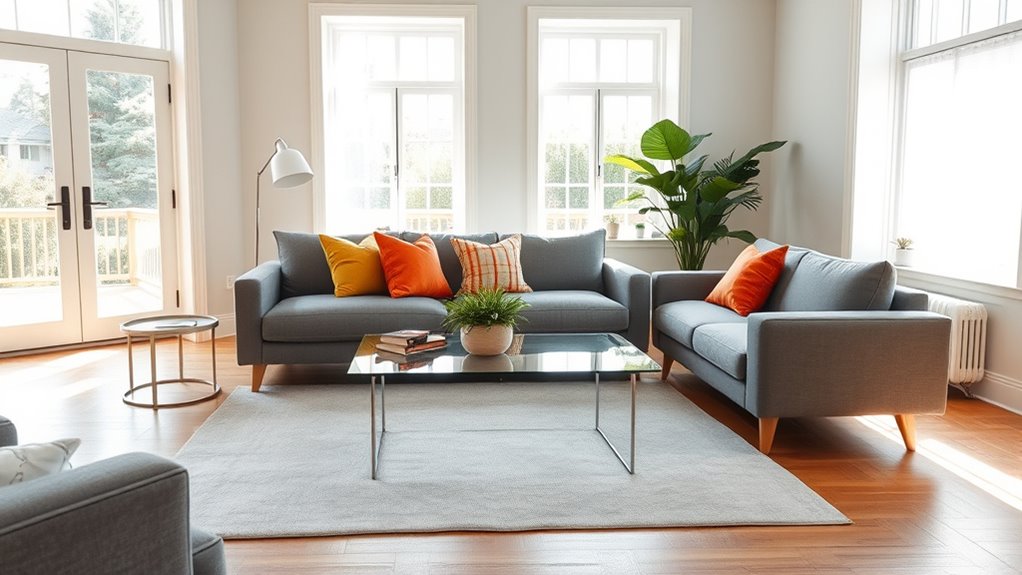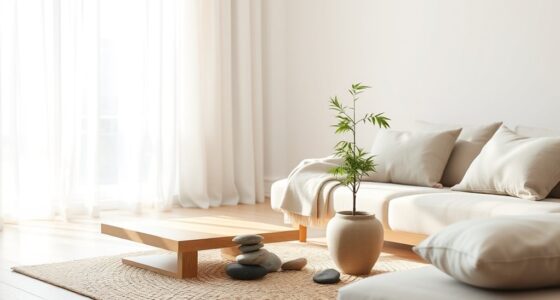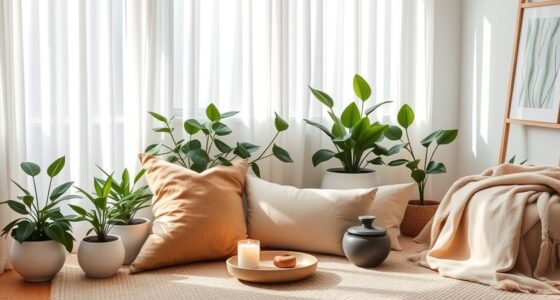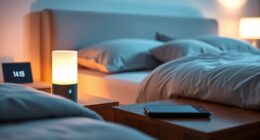Rearranging your furniture sparks a sense of novelty that releases dopamine, boosting your mood and mental clarity. Changing your space introduces sensory stimulation, sparks creativity, and disrupts routine, helping you feel more energized and in control. Moving furniture also provides physical activity, which releases endorphins and reduces stress. These effects combine to make you feel happier and more motivated. Keep exploring to discover how small changes can considerably improve your well-being.
Key Takeaways
- Rearranging furniture provides a sense of control, boosting confidence and empowerment over your environment.
- Novel spatial arrangements stimulate neuroplasticity, fostering mental agility and reducing stagnation.
- The physical activity involved releases endorphins, improving mood and reducing stress.
- Changes in environment create sensory stimulation, enhancing emotional well-being and promoting happiness.
- Fresh layouts break routine, inspiring creativity and giving a renewed sense of purpose and motivation.
The Psychological Impact of Novelty
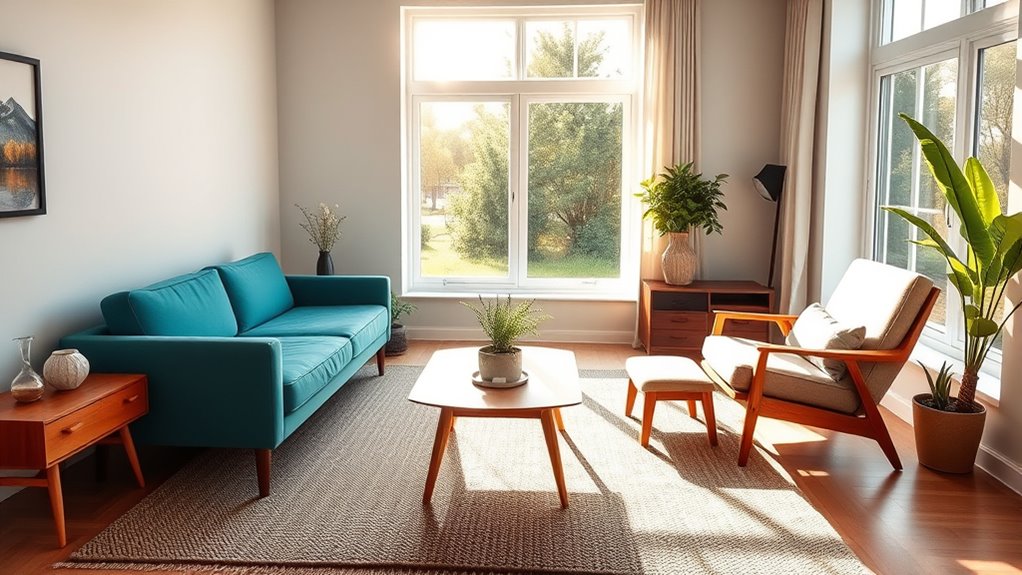
Have you ever noticed how a fresh arrangement of your furniture can instantly lift your mood? That’s because novelty sparks neuroplasticity, encouraging your brain to form new connections. When you change your space, you introduce fresh sensory stimulation—sights, textures, and spatial dynamics—that keep your brain engaged. This stimulation activates neural pathways, boosting mental agility and reducing feelings of stagnation. Your environment becomes a source of positive reinforcement, making you feel more energized and motivated. By simply rearranging furniture, you’re not just changing your surroundings; you’re giving your brain a healthy dose of novelty that enhances emotional well-being. Additionally, understanding store hours can help you plan your redecorating sessions more efficiently. This process highlights how small shifts in your environment can have a profound impact on your mental state, fueling your sense of renewal.
How Changing Spaces Boost Mood and Creativity
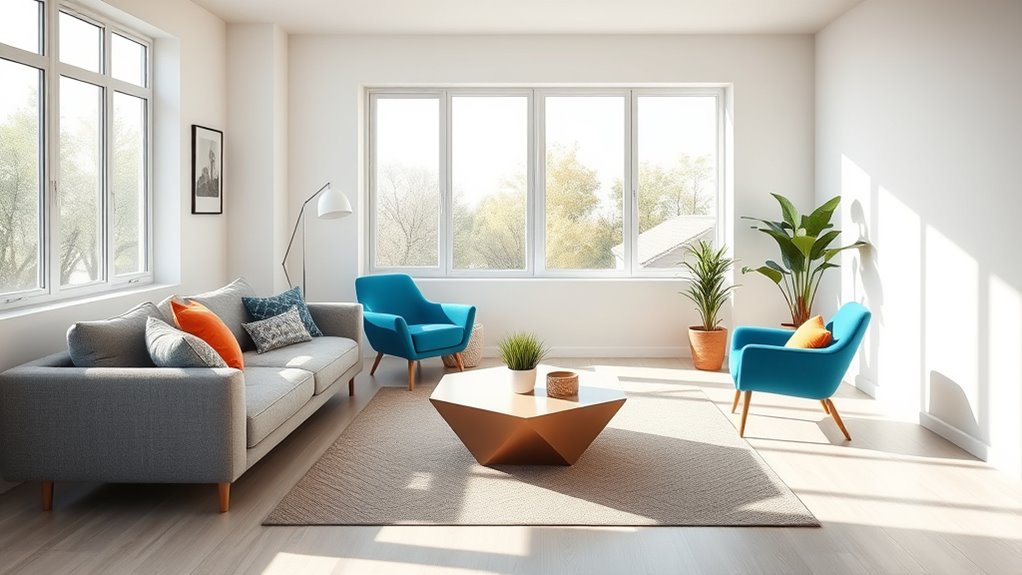
When you rearrange your space, you open the door to fresh perspectives that fuel creativity. This simple change can reduce stress and lift your mood, making you feel more in control. Plus, completing the task gives you a sense of achievement that boosts your confidence and motivation. Additionally, the act of reorganizing can stimulate your brain with new patterns, similar to how electric bike conversion kits enhance mobility and performance by integrating new technology.
Fresh Perspectives Spark Creativity
Ever wondered how a simple change in your surroundings can ignite your creativity? Rearranging furniture offers fresh perspectives that can drastically improve interior aesthetics and enhance spatial harmony. When you shift things around, you challenge your usual way of seeing a space, encouraging your mind to think differently. This newfound spatial arrangement can spark ideas and inspire innovative solutions. A well-balanced setup not only feels more inviting but also stimulates your creative flow. By tweaking your environment, you break free from stagnation, making your space feel energized and new. This simple act of change refreshes your outlook, helping you approach projects with renewed enthusiasm. Interestingly, engaging in these spatial transformations can also promote attention and focus, further boosting your creative potential. Ultimately, rearranging your furniture isn’t just about aesthetics; it’s about unlocking your creative potential through the power of spatial transformation.
Reduced Stress, Elevated Mood
Rearranging your space can considerably reduce stress and lift your mood, as changing your environment disrupts routine and promotes a sense of control. When you experiment with interior design, you actively engage in personal expression, which enhances feelings of satisfaction and happiness. Moving furniture and redecorating allow you to create a space that reflects your personality, fostering a positive emotional connection. This process can help break feelings of stagnation, boost creativity, and improve overall well-being. As you see your environment transform, your mood elevates, and stress diminishes. The act of redesigning isn’t just about aesthetics; it’s a powerful way to nurture your mental health by making your surroundings feel fresh, personalized, and uplifting. Additionally, understanding the psychology of change can deepen your appreciation of how environmental shifts positively influence your mental state.
Sense of Control and Accomplishment
Changing your space gives you a tangible sense of control, which can considerably boost your mood and spark creativity. When you rearrange furniture or update decorative accents, you actively shape your environment, reinforcing your ability to influence your surroundings. Adjusting color schemes or adding new decorative accents can make your space feel fresh and personalized, strengthening your feeling of accomplishment. This sense of mastery encourages you to take on new challenges and fosters confidence. As you see your efforts come together, you experience a rewarding sense of progress. The control you gain from these changes energizes your mindset, making your space not just more functional but also a reflection of your personal growth. That’s how small adjustments can create a big boost in your overall well-being. Sustainable living practices can further enhance this sense of achievement by aligning your environment with your values.
The Sense of Control and Empowerment
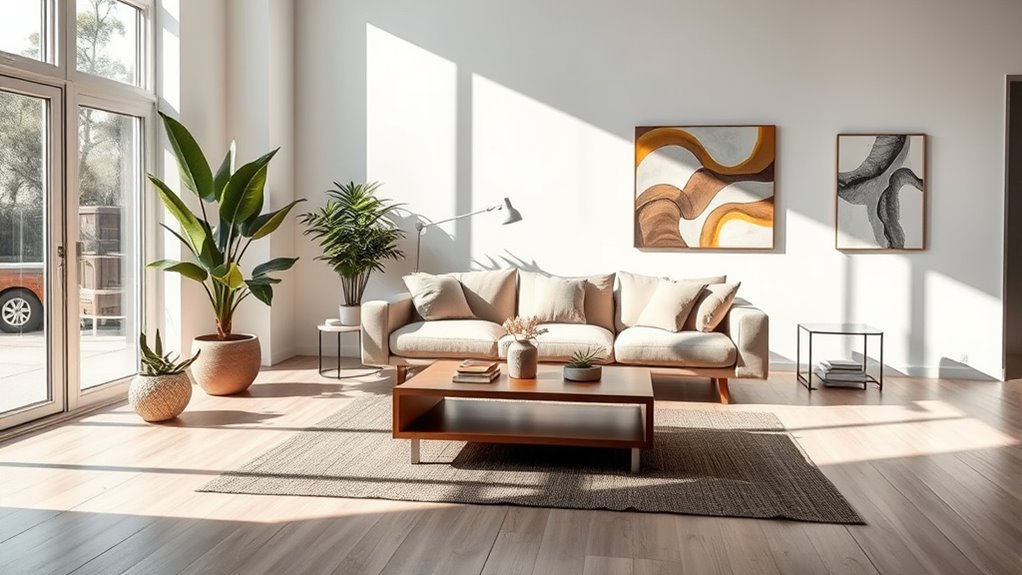
When you move furniture around, you instantly regain a sense of control over your environment. This act boosts your personal empowerment, making you feel more confident in your decision-making. By choosing where to place each piece, you take charge of your space, reinforcing your ability to shape your surroundings. This simple change reminds you that you have the power to influence your environment, fostering a sense of agency. As you see your efforts transform a room, your confidence in making decisions grows. Rearranging furniture becomes more than just physical work; it’s an empowering act that reminds you of your capacity to create positive change. Additionally, the process of rearrangement can also serve as a form of mindful decluttering, helping you evaluate and optimize your space for better organization and purpose. Ultimately, it strengthens your belief that you can shape your world, one decision at a time.
Breaking Monotony and Stimulating the Brain
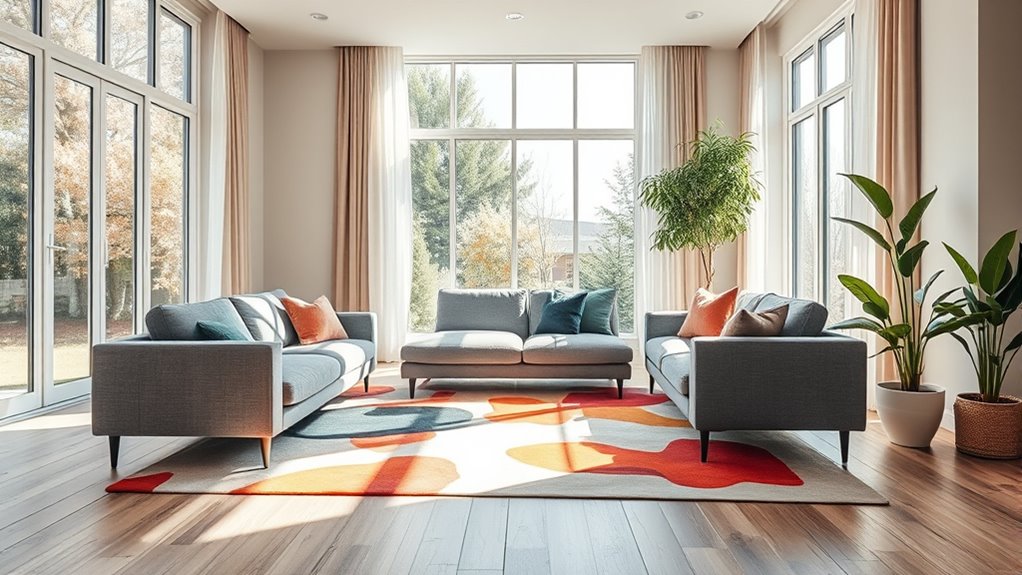
Alterating the layout of your space does more than just refresh the room; it actively stimulates your brain by breaking free from routine. When you rearrange furniture, you challenge your mind to adapt to new configurations, boosting creativity and mental agility. Staying on top of decorating trends often involves experimenting with different styles and layouts, which keeps your environment dynamic and engaging. Plus, considering furniture durability ensures your new setup remains functional and resilient over time, encouraging ongoing changes without worry. This process prevents your surroundings from becoming monotonous, energizing your thinking and mood. By intentionally changing your space, you invite fresh perspectives and mental stimulation, making your environment a catalyst for continual growth and innovation. Incorporating variety in your space also mirrors the benefits of breaking monotony, which can improve overall mental well-being.
The Role of Environment in Emotional Well-Being
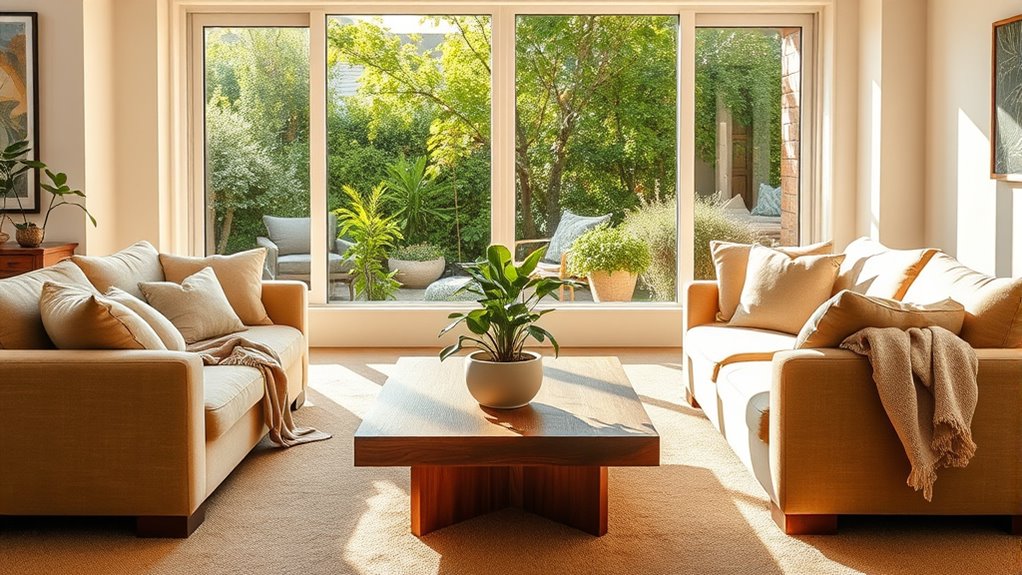
Your environment plays a essential role in shaping your emotional well-being, influencing how you feel and respond to daily life. When you rearrange your space, you’re actively modifying your personal space, which can boost feelings of control and comfort. An organized, inviting environment helps reduce stress and anxiety, making you feel more at ease. Additionally, your surroundings impact social interactions—an inviting layout encourages connection and communication with others. When your space feels right, you’re more likely to invite friends over or engage positively with family. Small changes in your environment can create a sense of renewal, helping you feel more balanced and emotionally resilient. Incorporating elements of Italian cuisine, such as the comforting textures of cheesy polenta or the vibrant colors of roasted red peppers, can also enhance your space’s warmth and appeal. Ultimately, your environment is a powerful tool in fostering a healthier, happier mindset.
Physical Movement and Its Mental Benefits
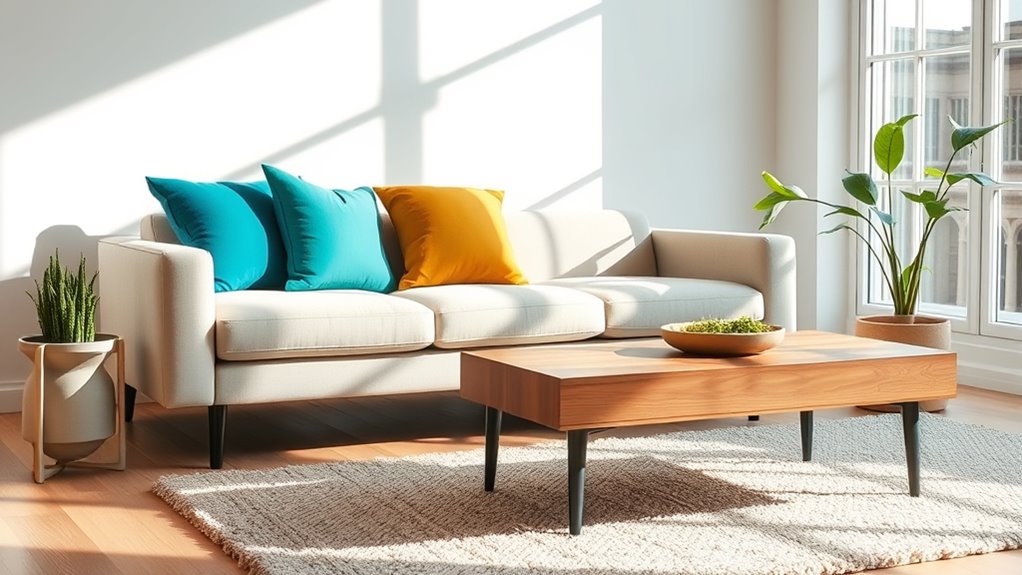
Rearranging your space can create a fresh, motivating environment, but moving your body offers immediate mental benefits that amplify this sense of renewal. When you engage in physical movement, you boost your mood, reduce stress, and improve focus. Incorporating physical exercise during your rearrangement process not only energizes you but also enhances ergonomic benefits, making your space more comfortable and supportive. Here are three key benefits: 1. Elevates mood through the release of endorphins 2. Reduces stress and anxiety by promoting relaxation 3. Improves posture and ergonomic support, preventing discomfort airless technology, which can improve the efficiency of your tasks.
Practical Tips for Effective Furniture Rearrangement

Before moving furniture, take time to plan your space carefully. Try out different layouts by sketching or using a room planner to see what works best. Testing arrangements first helps you avoid unnecessary effort and guarantees your new setup feels just right. Incorporating a farmhouse-inspired cozy textiles can also enhance your comfort and aesthetic appeal during the redesign process.
Plan Your Space
Have you ever wondered how to make your space feel more inviting and functional? Planning your space is key. Start by defining your decor themes—modern, rustic, or minimalist—and choosing furniture styles that match. This creates a cohesive look and makes rearranging easier. Next, consider the flow of your room: aim for clear pathways and balanced arrangements. Finally, measure your space and furniture to ensure everything fits comfortably.
Here are three practical tips to help you plan effectively:
- Sketch a layout to visualize different arrangements.
- Prioritize focal points, like a fireplace or window.
- Keep scale in mind to maintain harmony among pieces.
Planning ahead makes rearranging smoother and more satisfying.
Test Layouts First
Testing layouts before moving heavy furniture saves time and effort. Use tape or paper templates to map out different arrangements, helping you visualize how your decorating themes and color schemes will work together. Experiment with various furniture placements, considering focal points like fireplaces or windows, to see what feels most balanced and inviting. This step allows you to identify the best layout without lifting or dragging pieces repeatedly. Keep in mind, a well-planned layout enhances your room’s functionality and aesthetic appeal. By testing multiple configurations first, you avoid unnecessary moves, reduce frustration, and ensure your space reflects your style and personality. Taking this extra step makes the actual rearrangement smoother, more satisfying, and aligned with your overall decorating vision.
Frequently Asked Questions
Does Rearranging Furniture Help Reduce Stress or Anxiety?
Rearranging your furniture can indeed help reduce stress and anxiety. When you change your space, it boosts decor mental health by creating a fresh environment that feels more in control. Plus, space symbolism plays a role—altering your surroundings can symbolize new beginnings, encouraging positive emotions. This act of rearrangement fosters a sense of accomplishment, calming your mind, and helping you feel more relaxed and centered in your space.
How Often Should I Change My Room Layout for Mental Health Benefits?
You should consider changing your room layout every few months to boost mental health through space optimization and interior aesthetics. Regularly rethinking your space helps prevent stagnation, refreshes your environment, and reduces stress. Pay attention to how you feel with each change, and adjust accordingly. This proactive approach keeps your space inspiring and functional, ensuring it continues to support your well-being while maintaining a visually appealing environment.
Can Furniture Rearrangement Improve My Focus and Productivity?
Rearranging your furniture can boost your focus and productivity by improving ergonomic design and increasing spatial awareness. When you optimize your space, you reduce distractions and create a more comfortable environment, making it easier to concentrate. Moving things around refreshes your mindset, helping you feel more energized and motivated. Regularly adjusting your layout guarantees your workspace stays ergonomic and inspiring, ultimately enhancing your ability to stay focused and productive.
Are There Specific Colors or Arrangements That Enhance Relaxation?
Imagine transforming your space into a haven of calm—certain colors and arrangements hold the key. Color psychology suggests soft blues and greens promote relaxation, while warm hues energize. Feng shui principles guide you to position furniture for harmony, creating a peaceful flow. When you combine these strategies, your environment becomes a sanctuary that naturally eases stress, making every moment in your space more soothing and restorative.
How Does Rearranging Furniture Affect Long-Term Emotional Attachment to Space?
Rearranging your furniture can strengthen emotional bonds with your space by invigorating your perception of it. When you change the layout, you actively engage with your environment, fostering a sense of ownership and connection. Over time, this renewed space perception helps you develop positive emotional attachments, making your environment feel more personalized and comforting. This ongoing interaction keeps your space feeling dynamic, nurturing a deeper emotional connection long-term.
Conclusion
Rearranging your furniture isn’t just about freshening up a room; it’s a powerful way to boost your mood and creativity. Imagine rearranging your living space and feeling a renewed sense of control and inspiration—like Sarah, who found her new setup sparked her passion for painting again. Small changes can break routines, stimulate your brain, and improve your emotional well-being. So go ahead, shuffle things around—you might just open a new sense of happiness and clarity.
